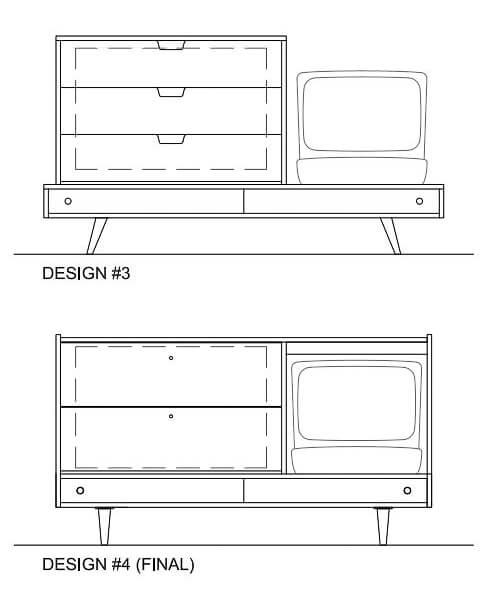

Hi Pam!
I recently read your story on Jeff’s mid-century modern TV cabinet he made for his flat screen TV and was inspired to write you about a similar experience — I also tackled the issue of how to hide a modern flat-screen TV in a mid century living room.
Almost two years ago, my partner and I were lucky to purchase a 1955 modest mid-century time capsule ranch complete with original furniture, pink bathroom, circa-60’s remodeled kitchen, and even a Tretchikoff print (!) in the living room. Being our first home, this worked out great because we didn’t have a lot of our own furniture. It was perfect for us and we were very lucky to find it.
Though one item we did have, a 1955 GE TV, we knew definitely needed to be displayed in the living room of our 1955 ranch. But this caused an issue, how do you have a vintage TV for when you’re in the mood for the Twilight Zone, and also have a flat screen TV for when you’d like to watch Netflix? This sent me on my adventure into woodworking and furniture building.
With my problem in mind, I designed and built a cabinet [not the one shown in these photos] that concealed the flat screen TV behind doors when not in use and looked good next to the 1955 TV. Long story short, it worked, but I wasn’t in love with the results. I decided I could do better and that this served as a great learning experience, being my first real exercise in building a piece of furniture.
So, for the next year, I scoured the internet for images of mid-century credenzas and cabinets for inspiration and slowly accumulating a Pinterest page of different possibilities. I was inspired by the simplicity of Paul McCobb’s furniture and used it as a jumping off point. I knew I needed to design something that would discreetly hide the flat screen without it being obvious what was behind its doors, so the doors couldn’t be too big, and they needed to fold away so they wouldn’t impede the view of the flat screen TV.
I work as a project manager for a local architecture firm so I drew up multiple options in AutoCAD looking at different designs and playing with the proportions to see what size flat-screen TV looked best and worked within the design. The flat screen needed to be discreetly hid without it being obvious what was behind its closed doors so the doors couldn’t be too big. Another lesson I learned from building the first TV stand was that the doors needed to operate easily and fold away so they wouldn’t impede the view of the flat screen TV.
When I thought I was happy with the design, I even built a full size card-board mock-up of the TV stand, because I knew I wanted to be sure this would work and I’d be happy with it knowing how much time, energy, and money I’ll be putting into it. After months of planning I was ready to get down and dirty and start building. This inspired me even more and the design changed further. I made more tweaks in AutoCAD and finally felt I was happy with the design. It was time to get down and dirty with construction.
Two months later I finished the project and I loved the results! I designed and built it myself – it was a great experience!
The design features a spot for our 1955 TV and conceals the flat-screen TV behind two folding doors that are disguised as drawers. Because the old TV was so deep, and the flat screen so shallow, the design features a shelf that perfectly fit one of our ceramic panthers which further helped disguise the flat screen TV when not in use. Below the shelf in the lower section of the cabinet is two sliding doors that we use to hide all the TV equipment for both TVs. One side of the cabinet has the equipment for the flat screen TV (Bluray player and Ninetendo Wii) and the other side has the equipment for the 1955 TV (RF modulator and DvD player).
The cabinetry is actually built very similarly to how Jeff built his TV cabinet. I used birch plywood, edge banding and the Kreg jig (affiliate link) (I actually fell in love with the Kreg jig and highly recommend it!). You can see the MccCobb inspiration in the legs, which areMcCobb furniture legs from tablelegs.com, and the hardware, which is from myknobs.com.
It definitely isn’t easy, but well worth it in the end! This was a great experience for me, and as Jeff mentioned, if you’d like to share it to inspire others with their mid-century projects, that would be great!Thanks!Chris
Thank YOU, Chris, for sharing all your work. This is really inspiring — I’d say your design is ready for Design Within Reach! I’m taking a weeklong Woodworking 101 class in April, this is definitely getting my juices going, although I am not sure I should be trusted around power saws.
The post Chris’s DIY midcentury modern TV cabinet inspired by Paul McCobb appeared first on Retro Renovation.









Find the best privacy door knobs for bedrooms and bathrooms, combining style, functionality, and security. Upgrade your home with premium Privacy Door Knobs designed for comfort and convenience
ReplyDelete